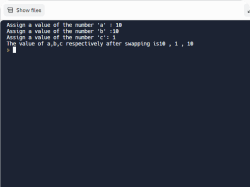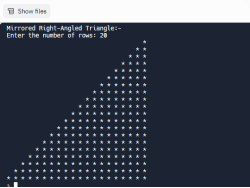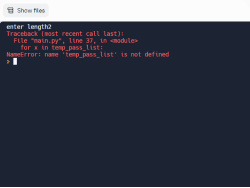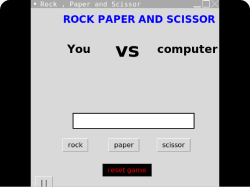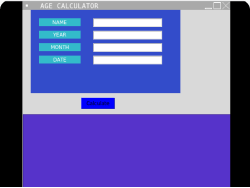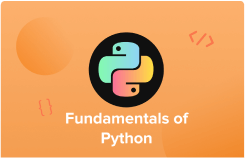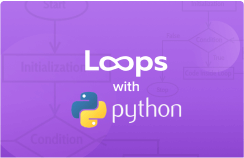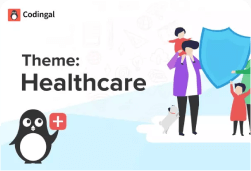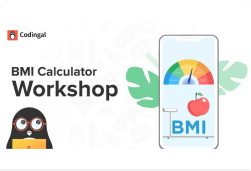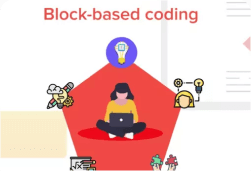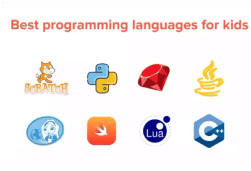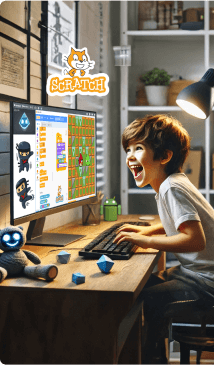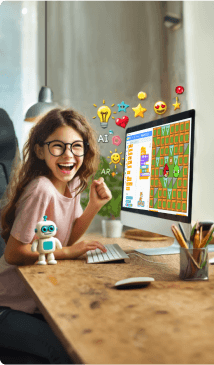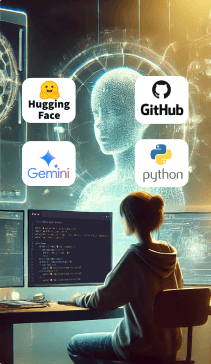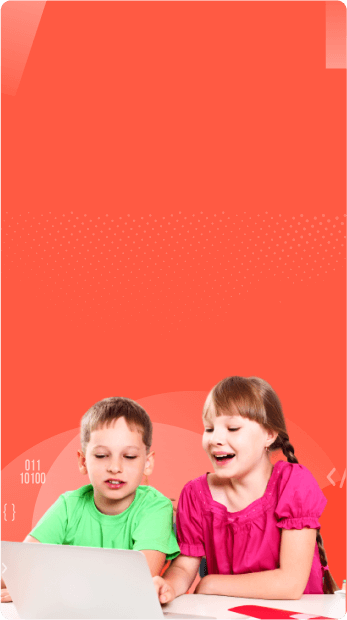Python Champion: Enhance Your Skills
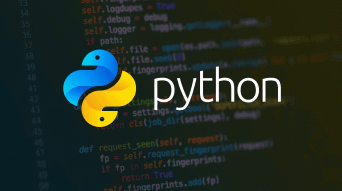
Learn Python with the Top Coding Course Instructors for Kids and Teens
Online 1:1 Python programming classes for kids with expert Computer Science teachers
7 Modules, 44 Lessons, 100+ Activities & Projects, 44 Quizzes
4.8 / 5 stars | Read reviews | 10,000+ students
This course includes:
44 live private 1-on-1 sessions of 45 mins each
Learn live with expert Computer Science teacher
7 detailed modules
100+ activities & projects
Stem.org accredited certificate
Python developer certificate
Lifetime access to course content
Unlimited 1:1 live doubt sessions with instructors
Live 1:1 class with Coding Instructor
Receive monthly progress reports
What is Python for Kids and Teens?
Python is a text-based programming language suitable for kids to learn. It is one of the most popular programming languages. Python is used to develop apps and software. For example, YouTube and Instagram are built using Python.
Python is used for web development, game development, building apps, machine learning, and more. Python Classes For Kids and Teens will quickly introduce them to principles of coding concepts and boost their analytical skills
Python programming teaches kidsand teens concepts of variables, keywords, operators, loops, if-else statements, conditional statements, functions, recursion, exception handling, list, dictionary, data structures, object-oriented programming, and more. In this course, students will also learn to build a game and GUI from scratch using Python.
Python programming will help kids and teens to get a grip on the basics of programming. Then, as kids explore what Python coding offers, they can learn various coding skills, from problem-solving to analytical thinking, that will grow with them on their coding journey beyond Python. It breaks coding into more easily grasped chunks so children can build their understanding while actively building actual code. It also helps the kids and teens to solve real-world problems using data structures and object-oriented programming in Python.
Our Python Class Curriculum
7 Modules, 44 Lessons, 100+ Activities & Projects, 44 Quizzes

Module 1
Python Basics
Lesson 1: Welcome to Python programming
Learn about computer programs, different programming languages, introduction to Python, the history of Python, algorithms, flowcharts, and repl.it platform.
Lesson 2: Getting started with programming
Introduction to print statements, identifiers, keywords, and variables in Python.
Lesson 3: Data types in Python
Learn about data types, typecasting, user input, and string operations.
Lesson 4: Python operators I
Learn about Python operators and the application of various basic operators in Python.
Lesson 5: Conditional statements
Learn about decision-making statements in Python programs. Also, learn to use the if-else statement.
Lesson 6: Python operators II
Learn about conditional statements if, elif, else, and the logical operators used in Python programming.
Lesson 7: Python operators III
Learn about identity operators, membership operators, and bitwise operators and the application of these operators in Python programming.
Lesson 8: Python challenge
Learn to write programs using all the concepts learned in the module.

Module 2
Loops in Python
Lesson 1: Nested conditional statements
Learn about nested conditional statements, the basics of conditional statements, and work on nested conditional statements in Python programming.
Lesson 2: Loops
Learn about programming loops and their types, the use of loops in programs, and how to work with them to solve various problems.
Lesson 3: While loop
Get introduced to the while loop, how and when to use them in your Python program.
Lesson 4: Nested loop
Learn about nested loops, how to use nested loops, and the syntax of the nested loops in the Python program.
Lesson 5: Patterns
Get introduced to nested loop’s application and how to make exciting patterns through nested loops in Python programming.
Lesson 6: Introduction to turtle
Learn about Turtle library in Python to create graphics and learn some essential functions used in the Turtle library.

Module 3
Python Functions and Modules
Lesson 1: Function
Get well equipped with knowledge of the basics of functions in Python.
Lesson 2: Arguments
Get introduced to arguments in Python functions, types of arguments, recursion, and docstring here.
Lesson 3: Keywords
Learn about a few essential keywords like return, continue, break, and pass in a Python program.
Lesson 4: Exception Handling
Learn about exception handling, various error handling techniques, and essential exceptions in Python.
Lesson 5: Random and math module
Learn about the Random and math module, know about predefined and essential methods in your Python program that these libraries provide.
Lesson 6: Date, time, and calendar
Learn about the Python program's date, time, and calendar module.

Module 4
Data Structures in Python
Lesson 1: Getting started with Lists
Get introduced to data structures, create a list, and perform operations on a list.
Lesson 2: It's a tuple!
Learn about tuple and perform operations on a tuple.
Lesson 3: All about Dictionary
Get introduced to Python data structure - Dictionaries and perform various operations and iterations on the dictionary in Python.
Lesson 4: Sets and Arrays
Learn about sets and arrays used in Python and perform different operations on sets and arrays.
Lesson 5: Advanced Python functions
Learn advanced functions used in Python programming like - map, zip, and exit, also the concepts of list comprehension and dictionary comprehension.
Lesson 6: Create games
Create games like Tic Tac Toe and Number Guessing Game using all the previously learned concepts.

Module 5
Object Oriented Programming
Lesson 1: Object-Oriented Programming
Get introduced to basic object-oriented programming concepts in Python, like - objects, classes, and attributes.
Lesson 2: More on Object-Oriented Programming
Learn about essential concepts of Object-Oriented Programming to understand how classes work.
Lesson 3: Inheritance
Get introduced to inheritance in Python and implement inheritance in Python to make the code reusable.
Lesson 4: Encapsulation and Special functions
Learn about encapsulation that helps you restrict access to variables and methods.
Lesson 5: Abstraction and Polymorphism
Get knowledge about abstraction and polymorphism to showcase only the essential aspects and hide the inner workings/implementation.
Lesson 6: Challenges in Object-Oriented Programming
Learn about operator overloading and practice previously learned concepts of Object-Oriented Programming in Python.

Module 6
Game Building with Pygame
Lesson 1: Let’s begin with Pygame
Learn about basic concepts of the game building using Pygame and create video games through the Pygame library.
Lesson 2: Basic game building concepts
Create polygons using the functions of Pygame and use key detection in the game.
Lesson 3: Let's Add Sprites
Learn to add sprites to the Pygame Screen and control them in the game.
Lesson 4: Let's Level Up The Game
Learn to make a game interactive with different effects like catchy background, collisions, and sound to your game.
Lesson 5: Space Invader Project - Part 1
Build the capstone project of a space invader game to implement all the learnings of Pygame.
Lesson 6: Space Invader Project - Part 2
Build the capstone project of a space invader game to implement all the learnings of Pygame.

Module 7
GUI using Python Tkinter
Lesson 1: Widgets for starters!
Learn about the basics of the Python library Tkinter and the different widget options available.
Lesson 2: Tkinter geometry managers
Learn how to use various geometry managers to organize better and control your GUI application layout using Python Tkinter.
Lesson 3: Where’s the event?
Learn about events, use event handlers in Tkinter, and increase an application's interactivity by using a message box.
Lesson 4: Build a text editor
Create a text editor application using the Python Tkinter library, and learn to open and save the files using Tkinter in Python.
Lesson 5: Denomination calculator
Learn to use Top Level in the Tkinter library to add multiple windows to the application.
Lesson 6: Restaurant Management System
Create a Restaurant Management System application using all the concepts from the Tkinter library of Python.
Learn coding from experienced teachers. Our hand-picked coding tutors ensure the best learning experience.
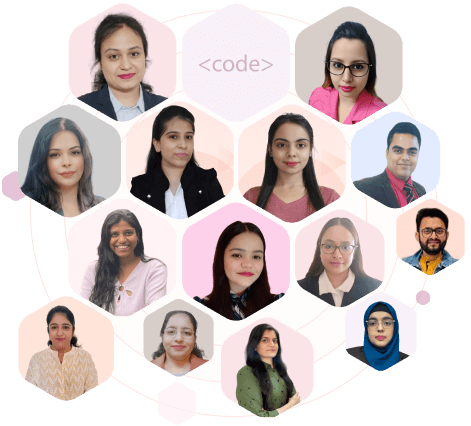
🎓 300+
graduate IT Instructors from India👨💻 7+
Years coding experience👩 91%
Female teachers💻 10+
Coding languages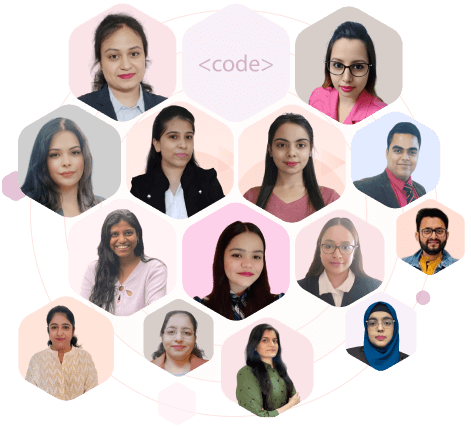
The best place for kids and teens to learn Python basics and fundamentals
Learn basics of programming, code interactive apps and games with this intensive online Python for Kids course.

Skills you’ll gain
Learn the foundation of Computer Science using Python programming
Become an expert in Python programming
Learn to solve problems by creating app, games, websites
Develop creative thinking to solve the problems
Improve analytical thinking while creating your projects on Python
Create engaging games, animation & apps with Python programming
With Codingal Prime, your child gets private tutoring from best instructors
Experience exclusive 1:1 online private tutoring
Handpicked top coding instructor as per your choice
Flexible number of weekly classes for your child
Unlimited doubt sessions, available 24x7. Absolutely free!
Personalized attention from instructor in each class
Flexibility to choose class timings & reschedule
Dedicated support team to resolve queries 24x7
Lifetime access to all class recordings
STEM.org accredited certificate for the course
Complete projects & Quizzes after every class
Receive monthly progress reports & attend PTMs
Flexible payment options available
Tailored curriculum for your child's interest & pace
Get assured 100% moneyback guarantee
Give an early advantage to your child with Codingal Prime - the premium learning program
Gamified Learning dashboard with projects & quizzes
Unlock your skills and earn your Python certification

Our young learners earn STEM.org-certified Python coding certificates for grades 6-12 that celebrate their achievements while unlocking special badges and leaderboard rankings, making programming a fun and rewarding experience. In this specialized Python course, learners can unlock three certifications—Young Python Programmer, Advanced Python Developer, and Python Game Developer—at different stages throughout the course. These certifications are easy to download and share, are STEM.org accredited, and can be added to your child's learning portfolio for sharing with the world and on social media.
90+ Fun activities and lessons for kids to learn Python programming
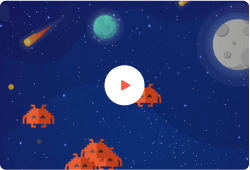
Space Invader game
Learn to create an exciting video game that can help the player shoot the space invaders and gain points using the Python library Pygame.
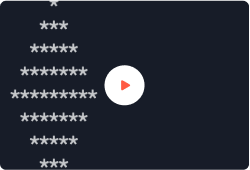
Diamond Pattern
Learn how to create a diamond shaped pattern using nested loops in Python.

Denomination Calculator
Create a multi window GUI application that can help the user to calculate the total number of denominations of 2000, 500 and 100 for amount entered, by using the Python library Tkinter.
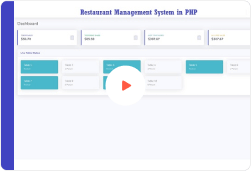
Restaurant Management System
Create a Restaurant Management System to bill and track orders using the Python library Tkinter.
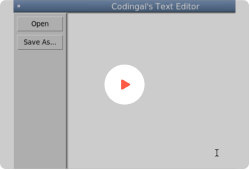
Text Editor
Build text editor to save and open your files using the Python library Tkinter.
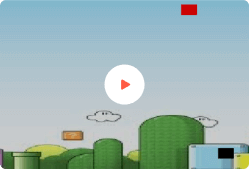
Pygame
Create exciting games you played in your childhood using the Pygame library in Python.
Amazing projects our students have created through our program
Python for Kids provides students certificates accredited by STEM.org.

STEM.org Educational Research is the longest continually operating STEM education research and credentialing organization that has served over 4,500 schools, districts, and organizations in over 25 countries. STEM.org Accreditation has been awarded to Codingal by STEM.org Educational Research after thoroughly examining and evaluating the educational institution’s curriculum, teachers, and courses for efficiency, effectiveness, and quality.
Codingal’s Python training course is loved by students and trusted by parents

Codingal has helped me learn Python by making the learning process fun and interactive. Colorful syntax and indentation make writing code enjoyable.

My teacher gives very clear instruction. With Python programming course by Codingal, I can create my own games.

Codingal has helped me transition from block based programming to text based programming through their Python programming course.

Codingal's Python programming course made it easier for my child to learn to build his favorite games.

The Python course at Codingal help me in scripting and creating data sets. The Python libraries make it easy to share code projects.

Codingal's personalized journey has really helped my child learn Python at her own pace and understanding.
Assess your knowledge with fun quizzes
Python for Kids masterclasses
Refresh your knowledge about Python for Kids and Teens with these informative concept-based videos
Resources related to Python Champion: Enhance Your Skills
Python for Kids: The Ultimate Guide to Learn Python
Python is one of the popular and versatile programming languages. It is beginner friendly and therefore the best programming language to start with. It is considered to be one of the most used languages in the world.
Read moreStrings in Python
Python string is a data type in which the programming language stores any data in a computer. Python string is an array of bytes. A string is a sequence of characters. It is among the most popular data types in Python.
Read moreLoops in Python
Loops are a formidable abstraction in Python. Iterative looping, which loops employ, helps us eliminate repetitive code. This is incredibly useful when you want to repeat a function numerous times.
Read moreTop 5 reasons why Python programming for kids is perfect for your child
Python is quick to learn even for kids or school students. Python programming is easy to read, write and learn. Tap on read more to know more about other reasons why Python programming for kids is perfect for your child.
Read moreDictionaries in Python
Dictionary in Python is a collection of key values used to store data like a map, unlike other data types, which hold only a single value as an element.
Read moreFrequently Asked Questions
Scratch is a free block-based programming language designed primarily for kids. It’s a visual programming interface where kids can code interactive stories, games, and animations and share their creations through an online community. Scratch coding courses for kids make learning fun and interactive.
A loop statement in Python programming allows you to run a statement or group of statements multiple times. For example, the ATM software is in a loop to process transaction after transaction until you acknowledge that you have no more to do. Sometimes, we are required to execute a code several times. So there, we use the concept of loops.
A function is a block of codes of related statements that performs a specific task. Functions help break our program into small blocks of code. As the program grows larger and larger, functions make it more organized and manageable. Suppose repeated code occurs in a program. The function can include those codes and execute them when needed by calling that function. Programmers working on large projects can divide the workload by making different functions.
An exception can be defined as an unusual condition in a program resulting in an interruption in the flow of the program. Whenever an exception occurs, the program stops the execution, and thus the other code is not executed. An exception is an object that represents the error. Python provides a way to handle the exception so that c can execute the code without any interruption.
Data Structures help you in storing the collection of data, managing it, and performing operations on them. Data Structures help you to make modifications easier on collections of data. In Python, we have four Data Structures- List, Dictionary, Tuple, and Set.
Object-Oriented Programming revolves around Classes and Objects and aims to increase the reusability of code. Object-oriented programming concepts create simpler code to understand, have higher readability, and are reusable. So, what exactly are these Classes and Objects? Consider Fruit as a class, Apple and Orange as Objects for better understanding. So, apples and oranges are real-world entities with some attributes and behavior. The primary idea behind OOPs is to combine data and the functions that operate with it into a single unit such that no other parts of the code may access it.
Python dictionary is a collection of items used to store data values. Each item in the dictionary has a key/value pair. Value of the key-value pair can be a number, a string, a list, a tuple, or even another dictionary. Python dictionary is defined by placing a sequence of items within curly {} braces. Python dictionary allows us to write effective codes.
You can download and install Python from Python software foundation website - https://www.python.org/
Python is the perfect coding language to get kids started off with. Python programming for kids helps improve and develop multiple facets of their educational syllabus including maths, writing, and creativity. It will help them develop a more concise and structured approach to storytelling with the English language. It will also aid them with problem solving too.Python leads them to developing simple and efficient solutions using critical thinking.Needless to say, Python developers are in high demand.
Yes, Python programming is kid-friendly. It is a programming language that is particularly good for kids wanting to learn how to code. Python is great for kids, especially as a first language. Kids new to python programming can go right from the very first simple “Hello world” programs to creating games in the future.
Python’s syntax is concise and easily readable by humans. It mirrors the human language far better than any other programming language which makes it an ideal language for beginners. Writing code in Python is similar to writing commands in plain English. As beginners, kids will quickly pick up the basics and learn how to use this language for game development and animation.
Coding for kids helps improve their logical thinking, critical thinking, problem-solving skills, creativity, mathematics and writing skills and also gives them valuable skills in life and at the workplace. Coding provides a competitive advantage when applying for colleges, internships, and jobs. In addition, basic programming knowledge can change how kids interact daily with the technologies they use. It’s a basic literacy–one we can’t afford to overlook.
Our coding courses for kids have been developed so that a complete beginner can follow along without any trouble. With technology increasingly prevalent across so many industries, even basic coding knowledge can help kids regardless of the career they ultimately decide to pursue.
Codingal is backed by esteemed investors
Codingal has secured substantial backing from renowned investment firms and a host of prominent angel investors

Hiro Mizushima
Investor, Actor

Peter Weck
Co-Founder, Simply Hired

Jonathan Hendriksen
Founder, Shuttlerock



Built by alumni of



Accredited by
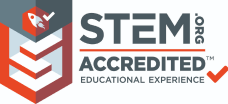
More recommended courses for you

App Development for Kids: Create AI-Powered Apps
Learning outcomes
Build Interactive Interfaces
Design Awesome Apps
Make Your App Super Smart (Integrate camera, accelerometers, GPS, etc.)
Share Your App with the World
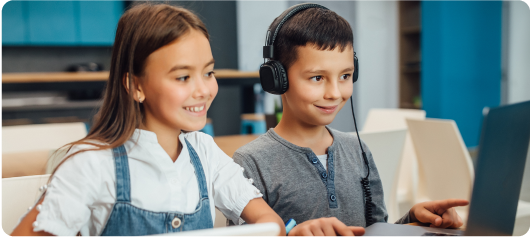
Website Development: Learn to Build Websites
Learning outcomes
Build responsive websites
Develop interactive web pages
Master website development
Implement best practices in web dev

AI Expert - Hands-On AI, LLMs & Python
Learning outcomes
Learn image processing with OpenCV.
Generate stunning AI images from text.
Implement AI speech-to-text.
Create text-to-speech generators.
Our Python course is appropriate for Middle School and High School students
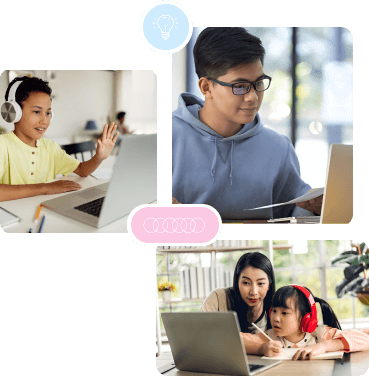
Our Python course is suitable for both middle school and high school students in grades 4 to 12. This course covers concepts such as data types, operators, conditional statements, and the Python library Turtle for creating graphics. Students will learn to debug code, create a game using the Pygame module, and be introduced to the Python library Tkinter to create GUI applications.
Codingal supports kids ages 6 to 18 and grades K to 12 by providing engaging and comprehensive coding education that fosters creativity and critical thinking skills.
